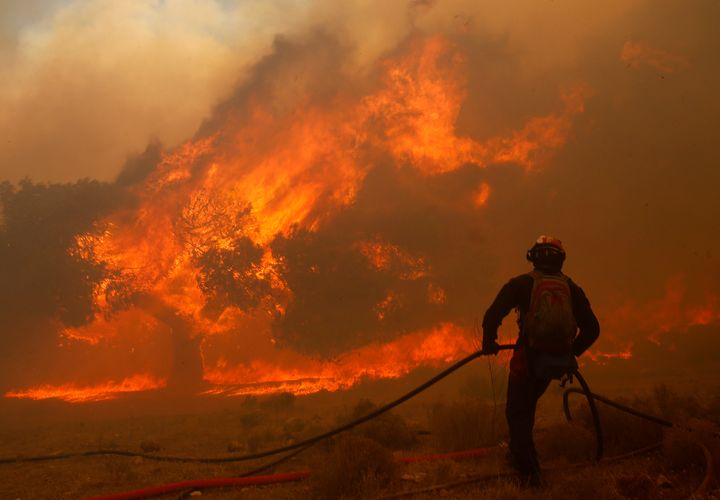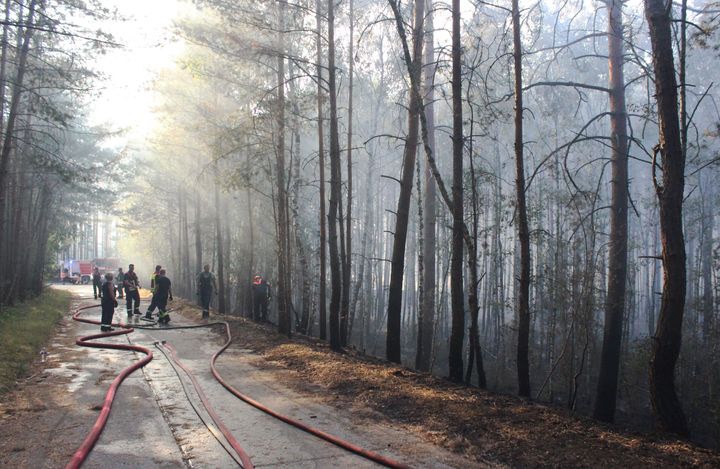
Drought turned the surrounding woodland into fuel, strong winds fanned the flames and in just a few hours this week fired consumed the Greek coastal resort of Mati, outside Athens. Homes and hotels were scorched or destroyed, more than 80 people died and many hundreds ran to the sea, seeking refuge from the flames.
Mati is the deadliest wildfire of 2018 so far, but the northern hemisphere fire season now extends from June until October, and more death and destruction is inevitable as one of the strongest, longest-lasting global heatwaves in decades continues to envelop countries from Siberia to the Mediterranean, from North America to East Asia. Temperature records keep getting surpassed, and there’s little rain in the forecast for many regions.
People have had to be evacuated from Yosemite National Park, Sweden has lost an estimated 30,000 hectares of forest and large areas of bone-dry Latvia, Italy, Finland and Norway have all been blanketed in smoke.
The 2018 wildfire season has been dramatic, prompting headlines about the world being on fire, but it is only unusual in that so many places are experiencing major fires at the same time, scientists say. Large blazes wracked Indonesia in 2015, Canada and Spain in 2016, and Chile and Portugal in 2017. In Russia, villages, farmland and more than 1,100 square miles of forest were destroyed in 2010, and again in 2015.
Fires used to be seen as local, but we should see them as part of a global-scale phenomenon.
In the United States, nearly 4 million acres across Arizona, Colorado, Idaho and Oregon have burned so far this year, about 10 percent more than the annual average at this time of year, but still nowhere near the 10 million acres that burned in 2015, according to the U.S. National Interagency Fire Center.
A 2016 report by the European Environment Agency suggests Mediterranean countries are seeing more heat extremes and reduced rainfall, resulting in more forest fires. The number of fires this year across Europe is up 40 percent on average, according to the European Forest Fire Information System.
The disastrous fires are due both to human behavior and planetary change, said David Bowman, a professor of environmental change biology at the University of Tasmania in Australia.
“Growing cities, poor planning, recurring heatwaves, more people living closer to forests and more combustible landscapes have together created a more fire-prone world,” said Bowman.
On top of these factors is the devastating impact of climate change, which through higher temperatures is now accelerating ecological instability. “It is causing fire seasons to start earlier and finish later,” said Bowman. “We are seeing more severe, more intense and longer lasting wildfires causing more loss of life and property. Fires used to be seen as local, but we should see them as part of a global-scale phenomenon.”
Studies in the U.S., Australia and Europe show wildfires increasing in number and scale, and becoming increasingly an urban problem.
“We are confronting more large fires, a tripling of homes burned and more frequent large evacuations in North America,” said Tania Schoennagel, a fire scientist at the University of Colorado Boulder. “This trend will continue in response to further warming.”

“Wildland fire can be a friend and a foe,” explains the U.S. Forest Service.
“In the right place at the right time, wildland fire can create many environmental benefits, such as reducing grass, brush, and trees that can fuel large and severe wildfires and improve wildlife habitat,” said a Forest Service spokesman. But In the wrong place at the wrong time, fires can threaten lives, homes and resources.
“Earth has evolved through fire and plants and humans have evolved to adapt to fiery landscapes,” said Andrew Scott, author of a new book, Burning Planet, and professor of geology at Royal Holloway, University of London. “Fire has become the enemy in cities, but we have to learn to live with it.”
The vast majority of fires are caused not by lightning or natural events, but by human error or vandalism, according to the U.S. National Park Service. As much as 90 percent are the result of things like campfires left unattended, the burning of debris, negligently discarded cigarettes or arson.
Growing cities, poor planning, recurring heatwaves, more people living closer to forests, and more combustible landscapes have together created a more fire-prone world.
“Changing climatic and weather conditions are exacerbating these problems,” said Fantina Tedim, a researcher at the University of Porto, Portugal. “Wildland is coming closer to settlements, rural areas are likely to be depopulated with the result that there is less management of forests and more build-up of flammable material.”
Because humans can start fires so easily, there is no simple way to prevent them, short of drastic and likely unfeasible solutions like removing people permanently from susceptible areas or redesigning landscapes to remove trees completely.
“Managing fire is about managing landscape,” said Bowman. “We are creating landscapes that are increasingly flammable. People are living in more and more dangerous environments because they believe technology will keep them safe.”
“We are just not prepared,” he continued. “Will there be more fires? With climate change, yes, lots more. We must get used to them, and learn to adapt. It’s like the earth has thrown down the gauntlet and we are paralyzed.”
CORRECTION: This story previously referred to the U.S. Fire Service. The agency is called the U.S. Forest Service.